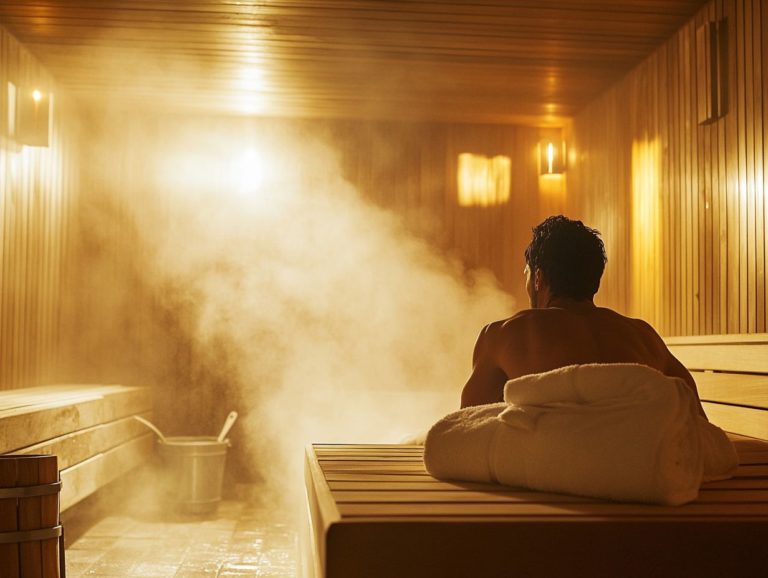The Impact of Environment on Sauna Safety
Saunas present a remarkable combination of relaxation and potential health benefits. Grasping the intricacies of sauna safety is essential for an enjoyable experience.
In this article, you will discover what saunas are and how they operate. Key environmental factors, including temperature, humidity, and ventilation, play a significant role in ensuring safety.
This article will also delve into health risks, necessary precautions, and specific considerations for children, pregnant women, and individuals with certain medical conditions.
Explore how to savor your sauna bathing sessions while prioritizing your well-being.
Contents
Key Takeaways:

- Saunas need the right temperature and humidity to be safe.
- Take special care if you re a child, pregnant, or have health issues.
- Stay hydrated and limit your time to enjoy your sauna safely.
Understanding Sauna Safety
Sauna safety is vital for fully enjoying the myriad health benefits that sauna bathing offers. These benefits include improved lung function, enhanced cardiovascular health, and deep relaxation.
There are two main types of saunas infrared and traditional. Understanding their differences, safety guidelines, and associated risks is essential for you.
This understanding enriches your sauna experience and maximizes the effectiveness of heat exposure while minimizing potential health risks. By selecting energy-efficient and sustainable materials for your eco-friendly sauna, and following specific usage guidelines, you can ensure a safe and rewarding sauna experience, especially for those in vulnerable populations. For more insights, check out sauna safety and accountability.
What is a Sauna and How Does it Work?
A sauna is a compact haven designed specifically for your relaxation. It offers dry or wet heat sessions through traditional or infrared heating methods.
Originating from Finland, it has woven itself into the fabric of wellness culture for centuries. In a traditional sauna, you ll find a wood-burning stove or electric heater that warms the air, creating a hot and humid embrace around you.
On the other hand, infrared saunas utilize infrared heaters that emit heat directly to warm your body without significantly raising the surrounding air temperature. This distinction leads to unique benefits.
The traditional sauna can prompt perspiration at higher temperatures, while infrared options allow for deeper tissue penetration at lower temperatures. This makes them appealing to a broader audience. Understanding these differences helps you choose a sauna experience that aligns with your health aspirations.
Environmental Factors that Affect Sauna Safety
Environmental factors are crucial to your sauna experience, especially concerning temperature and humidity levels. These elements significantly influence your comfort and overall health during your sessions.
Prioritizing the right conditions ensures you can enjoy the full benefits of your sauna while maintaining safety and well-being.
Temperature and Humidity
The temperature and humidity levels in a sauna are vital for ensuring your experience is both safe and enjoyable. When conditions are off, you might face discomfort or even health risks.
Aim for temperatures between 150 and 195 degrees Fahrenheit, with humidity levels around 10 to 20 percent. This sweet spot enhances relaxation and supports cardiovascular health by boosting circulation.
When heat is harmoniously paired with the right moisture, it creates a soothing ambiance that encourages detoxification and alleviates stress. Conversely, excessively high temperatures or humidity can lead to dehydration, dizziness, or even heat strokes. Understanding the importance of encouragement in sauna safety can help mitigate these risks.
This highlights the importance of keeping a close eye on these factors for a safe sauna session. By maintaining a comfortable environment, you can fully enjoy the numerous health benefits that come with regular sauna use.
Embrace the warmth of your sauna sessions, and always prioritize your health and safety!
Proper Ventilation

Proper ventilation in your sauna is essential for maintaining air quality and temperature stability. This directly enhances both safety and comfort during your sessions.
This vital element ensures that humidity is kept in check. It significantly reduces the risk of mold and bacteria growth that could compromise your health. With effective airflow, you ll find yourself in a refreshing environment that promotes relaxation and minimizes the chances of overheating.
To optimize ventilation, strategically placed vents allow fresh air to flow in while warm, humid air escapes. This creates a balanced atmosphere. The care you invest in these environmental factors elevates your sauna experience and shows a commitment to fostering a healthy space. Additionally, embracing sauna safety reflects your awareness of the ecological impact on personal wellness.
Health Risks Associated with Sauna Use
While saunas offer many health benefits, you must recognize the potential risks involved, especially if you have existing health issues like asthma, cardiovascular disease, or neurocognitive disorders. Being aware of these factors allows you to prioritize your well-being and fully enjoy the experience.
Potential Dangers and Precautions
Understanding the potential dangers of sauna use is crucial for ensuring a safe and enjoyable experience. This is especially true for at-risk populations, such as children, pregnant women, and older adults, who may have heightened health issues.
If you have existing cardiovascular issues or are pregnant, consult a healthcare professional before stepping into a sauna. Additionally, it’s crucial to be aware of sauna safety tips for local establishments, as staying properly hydrated is important; not having enough water in your body can significantly affect your health.
Limit your time in the sauna; staying too long can lead to overheating or heat exhaustion. Pay attention to your body s signals. If you start feeling excessively dizzy or uncomfortable, exit the sauna.
By keeping these precautions in mind, you can enjoy the multiple health benefits of saunas while minimizing any potential hazards.
Maximizing Safety in the Sauna
To maximize your safety in the sauna, implement a range of important safety measures and adhere to usage guidelines. This approach enhances your experience and mitigates any potential risks, allowing you to enjoy the full benefits of your sauna time.
Important Safety Measures
Implementing essential safety measures is vital for a safe sauna experience. These guidelines significantly reduce the risks of overheating, dehydration, and other potential hazards.
Prioritize proper hydration before and after each session to minimize dehydration, a common concern in high-temperature environments. Set time limits typically around 15 to 20 minutes per session to allow your body to acclimate without falling prey to fatigue or overheating. It’s equally important to monitor the sauna’s temperature, keeping it within a comfortable range, usually between 150 F and 195 F. Additionally, consider sauna safety practices to enhance your overall experience.
Be aware of your personal tolerance levels, as each person’s response to heat can vary significantly. This awareness helps mitigate health risks associated with prolonged exposure, allowing you to enjoy the sauna experience to the fullest. For more insights, check out sauna safety: the impact of leadership.
Sauna Safety for Specific Populations

Sauna safety holds paramount importance for certain groups, including children, pregnant women, and older adults. Each of these groups may have distinct health considerations that require careful attention during their sauna experience.
Children and Pregnant Women
Both children and pregnant women encounter distinct health risks when using a sauna. It’s essential to adhere to specific safety guidelines to safeguard their well-being.
Children are more sensitive to heat. This can cause rapid overheating and dehydration. It’s crucial to supervise them closely and limit their exposure time. Always consult a pediatrician before introducing sauna sessions to your little ones and refer to guidelines on sauna safety to know the appropriate age and weight limits.
Pregnant women should also exercise caution when considering sauna use. Elevated body temperatures may pose risks to fetal development, especially during the first trimester. To minimize these risks, expectant mothers should keep their sauna visits brief and stay well-hydrated. For more insights on safe practices, always seek specific advice from their healthcare provider and consider the guidelines in sauna safety.
Individuals with Certain Health Conditions
If you have certain health conditions like asthma or cardiovascular disease, approach sauna use with caution. The heat can worsen your symptoms.
For anyone dealing with respiratory issues, that warm, humid environment might trigger potential attacks. Have an in-depth conversation with your healthcare professional before diving into sauna sessions. Similarly, if you have a heart condition, consider the effects of increased heart rate and blood circulation that come with elevated temperatures. It’s also important to be aware of sauna safety practices to ensure a safe experience.
Managing chronic illnesses? You ll benefit from customized advice on duration and temperature settings that cater to your specific needs. This ensures you strike a balance between relaxation and health safety.
In any scenario, consulting your healthcare provider can offer personalized insights. This enhances your sauna experience while prioritizing your well-being.
Frequently Asked Questions
How does the environment impact sauna safety?
The environment can greatly affect sauna safety. Extreme heat or humidity can make it hard for the body to regulate its temperature. This can lead to heat exhaustion or dehydration. Poorly ventilated saunas might cause a buildup of carbon monoxide, which can be toxic. The materials used to build the sauna also affect its safety. Certain woods or metals may be more prone to heat damage or emit harmful chemicals.
What temperature is safe for a sauna?

The ideal temperature for a sauna is between 150-195 F (65-90 C). Anything above this can be dangerous and increase the risk of heat-related illnesses. Always follow the manufacturer’s recommendations and avoid excessively high temperatures to ensure the safety of sauna users.
Is it safe to use a sauna during extreme weather conditions?
No, it is not safe to use a sauna during extreme weather conditions. This includes extreme heat, cold, or humidity. Saunas are designed to work within specific temperature and humidity ranges. Using them in extreme weather can put the body under unnecessary stress and increase the risk of heat-related illnesses.
How does ventilation impact sauna safety?
Ventilation is crucial for sauna safety. Proper ventilation helps regulate temperature and humidity inside the sauna. This prevents the buildup of harmful gases and reduces the risk of heat-related illnesses. Ensure that the sauna’s ventilation system functions properly and that the sauna is well-ventilated before use.
Can I use a sauna if I have a health condition?
Before using a sauna, check with your healthcare provider if you have a health condition. Some conditions, such as heart disease, high blood pressure, or respiratory issues, may worsen due to the extreme heat and humidity of a sauna. Always play it safe talk to a professional before using a sauna!
How can I ensure the safety of my sauna?
To ensure the safety of your sauna, follow the manufacturer’s instructions for use and maintenance. Regularly check and clean the sauna’s ventilation system and heating elements. Avoid using the sauna if you feel unwell or have been drinking alcohol. Always have a way to communicate with someone outside the sauna in case of emergencies.






